- Accueil
- Pages cachées
- 10 JUILLET 2023 NEWS
10 JUILLET 2023 NEWS
INSTITUT SUPERIEUR D'ANTHROPOLOGIE
INSTITUTE OF ANTHROPOLOGY
ONLINE COURSES / COURS A DISTANCE
DEBUT COURS : SEPTEMBRE 2023
REGISTER NOW
TURQUIE – 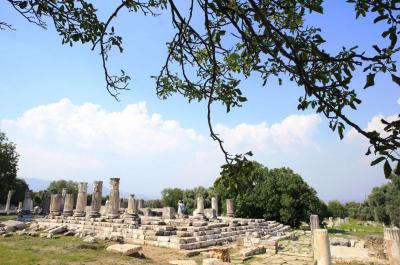 Stratonikeia - In a meticulous investigation, archaeologists led by professor Bilal Söğüt are exploring the remnants of the Lagina Hekate Sanctuary in the Yatağan district of southwestern Muğla focusing on understanding the extensive destruction caused by earthquakes that rocked the region during ancient times, Anadolu Agency (AA) reported on Friday. The excavation works on-site, once considered to be the center of pagan belief, which commenced over a century ago under the pioneering guidance of Osman Hamdi Bey, have persisted without interruption with professor Söğüt and his team carrying the torch forward. Söğüt, the head of the excavation teams at the sanctuary and the ancient city of Stratonikeia, speaking to AA noted that Lagina was the largest religious hub in the region in ancient times and also housed the largest temple built in the name of the goddess Hecate. Remarkably, this year's excavations have brought to light remnants from the Hellenistic, Roman and Eastern Roman periods, unveiling the past ceremonies held within the sacred grounds. Through the induction of 3D technology, visitors now have the unique opportunity of witnessing the architectural evolution of this remarkable site across various historical eras. Stating that the sanctuary and the surrounding settlement were affected by earthquakes in the ancient period, Söğüt said, "We are aware that the earthquake in 139 A.D. in the Roman period severely damaged the region. Especially through the studies we carried out in Lagina this year, we have found traces indicating that a powerful earthquake, possibly exceeding a magnitude of 7.0, devastated the region 365 B.C." "We are documenting how the structure, which consists of huge blocks connected both horizontally and vertically, collapsed due to the magnitude of the earthquake," he explained. Pointing out that the buildings of the period were built so well that they could hardly be burned, Söğüt noted that in some areas, they found that the structures were completely shifted to the east due to the effect of the earthquake. In collaboration with the Scientific and Technological Research Council of Türkiye (TÜBITAK) and the European Union, a comprehensive project involving geologists, archaeologists and architects is underway.
Stratonikeia - In a meticulous investigation, archaeologists led by professor Bilal Söğüt are exploring the remnants of the Lagina Hekate Sanctuary in the Yatağan district of southwestern Muğla focusing on understanding the extensive destruction caused by earthquakes that rocked the region during ancient times, Anadolu Agency (AA) reported on Friday. The excavation works on-site, once considered to be the center of pagan belief, which commenced over a century ago under the pioneering guidance of Osman Hamdi Bey, have persisted without interruption with professor Söğüt and his team carrying the torch forward. Söğüt, the head of the excavation teams at the sanctuary and the ancient city of Stratonikeia, speaking to AA noted that Lagina was the largest religious hub in the region in ancient times and also housed the largest temple built in the name of the goddess Hecate. Remarkably, this year's excavations have brought to light remnants from the Hellenistic, Roman and Eastern Roman periods, unveiling the past ceremonies held within the sacred grounds. Through the induction of 3D technology, visitors now have the unique opportunity of witnessing the architectural evolution of this remarkable site across various historical eras. Stating that the sanctuary and the surrounding settlement were affected by earthquakes in the ancient period, Söğüt said, "We are aware that the earthquake in 139 A.D. in the Roman period severely damaged the region. Especially through the studies we carried out in Lagina this year, we have found traces indicating that a powerful earthquake, possibly exceeding a magnitude of 7.0, devastated the region 365 B.C." "We are documenting how the structure, which consists of huge blocks connected both horizontally and vertically, collapsed due to the magnitude of the earthquake," he explained. Pointing out that the buildings of the period were built so well that they could hardly be burned, Söğüt noted that in some areas, they found that the structures were completely shifted to the east due to the effect of the earthquake. In collaboration with the Scientific and Technological Research Council of Türkiye (TÜBITAK) and the European Union, a comprehensive project involving geologists, archaeologists and architects is underway.
MEXIQUE – 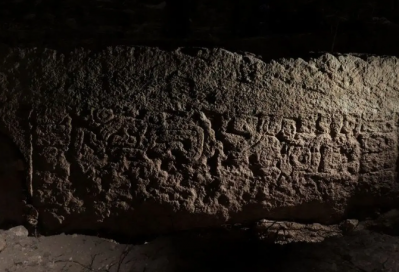
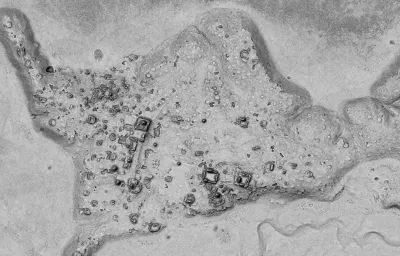 Ocomtún - Ocomtún, meaning “stone column”, is a Maya city recently discovered in the Balamkú ecological reserve using high resolution photography and Light Detection and Ranging (LiDar). The city covers an areas of around 123.5 acres and dates from around the Classic Period (AD 250-1000). By the 10th century AD, the population declined and the site was abandoned around the time of the Maya collapse, a period that saw the abandonment of many Maya cities in the southern Maya lowlands. Various large buildings have been confirmed through a ground level inspection, including several pyramidal structures over 15 metres in height, plazas, elongated structures arranged in a concentric circle plan, and evidence of a ball game court. A large causeway connects the southeastern part of the site to a cluster of buildings in the northwest where an 80 metre long rectangular acropolis is situated. Excavations have uncovered a large engraved megalithic stone block at the stairway in the northwest zone, measuring 1.82 metres in width and carved with scenes and Maya hieroglyphs. The block was originally part of a large monument such as a stela, stairway or lintel, and is carved with imagery depicting a Maya captive, a zoomorphic representation of a mountain, and incomplete hieroglyphic text in bands of cartouches. A closer examination of the text shows the logogram, ajaw , meaning “lord”, which alludes to a Mayan ruler or nobleman, and above are syllabograms that make the word Maatz’ – possibly meaning in combination, the “Lord of Maatz’”. According to the researchers: “Maatz’ could correspond to the original name of Ocomtún or to another place, as the practice of relocating monuments was common in the Maya area. Similar cases have been found in Chactún, Cobá, Calakmul or Tikal.” Excavations around the block also uncovered offerings, including a carved bone in the shape of an eight-pointed star, a bifacial flint point, and various ceramic fragments.
Ocomtún - Ocomtún, meaning “stone column”, is a Maya city recently discovered in the Balamkú ecological reserve using high resolution photography and Light Detection and Ranging (LiDar). The city covers an areas of around 123.5 acres and dates from around the Classic Period (AD 250-1000). By the 10th century AD, the population declined and the site was abandoned around the time of the Maya collapse, a period that saw the abandonment of many Maya cities in the southern Maya lowlands. Various large buildings have been confirmed through a ground level inspection, including several pyramidal structures over 15 metres in height, plazas, elongated structures arranged in a concentric circle plan, and evidence of a ball game court. A large causeway connects the southeastern part of the site to a cluster of buildings in the northwest where an 80 metre long rectangular acropolis is situated. Excavations have uncovered a large engraved megalithic stone block at the stairway in the northwest zone, measuring 1.82 metres in width and carved with scenes and Maya hieroglyphs. The block was originally part of a large monument such as a stela, stairway or lintel, and is carved with imagery depicting a Maya captive, a zoomorphic representation of a mountain, and incomplete hieroglyphic text in bands of cartouches. A closer examination of the text shows the logogram, ajaw , meaning “lord”, which alludes to a Mayan ruler or nobleman, and above are syllabograms that make the word Maatz’ – possibly meaning in combination, the “Lord of Maatz’”. According to the researchers: “Maatz’ could correspond to the original name of Ocomtún or to another place, as the practice of relocating monuments was common in the Maya area. Similar cases have been found in Chactún, Cobá, Calakmul or Tikal.” Excavations around the block also uncovered offerings, including a carved bone in the shape of an eight-pointed star, a bifacial flint point, and various ceramic fragments.
KAZAKHSTAN - 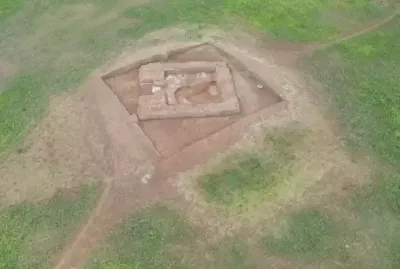 Korgalzhyn - Remains of a mausoleum dating back to the Golden Horde in the 15th century were discovered on the territory of the Korgalzhyn district in the Akmola Region a centrally located region of Kazakhstan, reported Khabar 24 news agency. The Archaeologists of Astana have already excavated several mausoleums in the area of the medieval town in Akmola region. This is the third historical monument discovered in Korgalzhyn district. The unique find is an octagonal structure. The length of each side slightly exceeds 1.5 meters, and the diameter is about 4.5 meters. The mausoleum was built of burnt and half-baked brick, fastened with lime mortar. Once this area was the site of pilgrimage. There was a tomb opposite the mausoleum. Due to its location on agricultural land, the condition of the mausoleum’s structures is estimated as poor. Besides, according to scientists, some burial structures were exposed to robberies, so there are no human remains in them. The presence of the mausoleum indicates the existence of a previously unknown cultural, political, and sacred center of the nomadic hordes who inhabited the steppes of Kazakhstan. The Golden Horde, also known as the Ulug Ulus ‘Great State’ in Turkic, was a Mongol and later Turkicized khanate founded in the 13th century as the northwestern sector of the Mongol Empire. When the Mongol Empire disintegrated after 1259, it became a functionally separate khanate. It is also referred to as the Kipchak Khanate or the Ulus of Jochi[a], and it succeeded the earlier less organized Cuman-Kipchak confederation. At its peak, the Golden Horde’s territory extended from the Carpathian Mountains in eastern Europe to the steppes of Siberia. On the south, the Horde’s lands bordered on the Black Sea, the Caucasus Mountains, and the Iranian territories of the Mongol dynasty known as the Il-Khans.
Korgalzhyn - Remains of a mausoleum dating back to the Golden Horde in the 15th century were discovered on the territory of the Korgalzhyn district in the Akmola Region a centrally located region of Kazakhstan, reported Khabar 24 news agency. The Archaeologists of Astana have already excavated several mausoleums in the area of the medieval town in Akmola region. This is the third historical monument discovered in Korgalzhyn district. The unique find is an octagonal structure. The length of each side slightly exceeds 1.5 meters, and the diameter is about 4.5 meters. The mausoleum was built of burnt and half-baked brick, fastened with lime mortar. Once this area was the site of pilgrimage. There was a tomb opposite the mausoleum. Due to its location on agricultural land, the condition of the mausoleum’s structures is estimated as poor. Besides, according to scientists, some burial structures were exposed to robberies, so there are no human remains in them. The presence of the mausoleum indicates the existence of a previously unknown cultural, political, and sacred center of the nomadic hordes who inhabited the steppes of Kazakhstan. The Golden Horde, also known as the Ulug Ulus ‘Great State’ in Turkic, was a Mongol and later Turkicized khanate founded in the 13th century as the northwestern sector of the Mongol Empire. When the Mongol Empire disintegrated after 1259, it became a functionally separate khanate. It is also referred to as the Kipchak Khanate or the Ulus of Jochi[a], and it succeeded the earlier less organized Cuman-Kipchak confederation. At its peak, the Golden Horde’s territory extended from the Carpathian Mountains in eastern Europe to the steppes of Siberia. On the south, the Horde’s lands bordered on the Black Sea, the Caucasus Mountains, and the Iranian territories of the Mongol dynasty known as the Il-Khans.
TURQUIE – 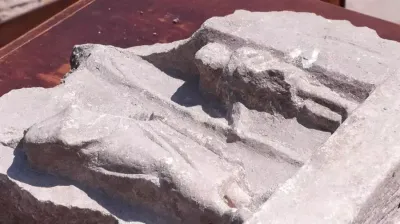 Saraçhane - Three grave stele fragments have come to light during the ongoing excavations by the Istanbul Metropolitan Municipality Heritage team in the Saraçhane Archeology Park. The new artifacts have been unearthed during the excavations in the Saraçhane Archaeology Park, where St. Polyeuktos Church is located in the Fatih neighborhood. Four new artifacts thought to have been used as spolia have also come to light in a different wall ruin located approximately 70 centimeters from the surface of the northern section of the structure, where excavations were carried out. It was determined that three of these works were grave steles. It was reported that there are various symbols on the grave steles, which indicate the status, profession and interests of the dead ones. “With a very special surprise, the excavation team found three grave steles with reliefs. These finds are extremely important to us in terms of Istanbul's urban history and archaeological richness because the last 100 years of the city are full of rapidly destroyed archaeological sites. Unfortunately, with these losses, the city’s history has been erased and disappeared. We are trying to show how valuable the city is with the Polyeuktos excavations, Bukoleon Palace excavations and lost architectural excavations,” Polat said. “The stele, which depicts a female figure, dates between the 3rd and 5th centuries. After finishing the works at Polyeuktos Church, we will move to the part we now call the Roman Palace. In this section, the materials used in the decoration of the palace itself started to appear much more. These artifacts were found 70 centimeters below the excavation level. This is an area where there is such an enormous cultural data, and it is an area where careful excavations should continue.” We are excited to see if this grave stele has a reference to Anicia Juliana [a Late Antique Roman imperial princess]. All this information reminds us that it was a big city center at a time before Hagia Sophia was built 1,500 years ago.
Saraçhane - Three grave stele fragments have come to light during the ongoing excavations by the Istanbul Metropolitan Municipality Heritage team in the Saraçhane Archeology Park. The new artifacts have been unearthed during the excavations in the Saraçhane Archaeology Park, where St. Polyeuktos Church is located in the Fatih neighborhood. Four new artifacts thought to have been used as spolia have also come to light in a different wall ruin located approximately 70 centimeters from the surface of the northern section of the structure, where excavations were carried out. It was determined that three of these works were grave steles. It was reported that there are various symbols on the grave steles, which indicate the status, profession and interests of the dead ones. “With a very special surprise, the excavation team found three grave steles with reliefs. These finds are extremely important to us in terms of Istanbul's urban history and archaeological richness because the last 100 years of the city are full of rapidly destroyed archaeological sites. Unfortunately, with these losses, the city’s history has been erased and disappeared. We are trying to show how valuable the city is with the Polyeuktos excavations, Bukoleon Palace excavations and lost architectural excavations,” Polat said. “The stele, which depicts a female figure, dates between the 3rd and 5th centuries. After finishing the works at Polyeuktos Church, we will move to the part we now call the Roman Palace. In this section, the materials used in the decoration of the palace itself started to appear much more. These artifacts were found 70 centimeters below the excavation level. This is an area where there is such an enormous cultural data, and it is an area where careful excavations should continue.” We are excited to see if this grave stele has a reference to Anicia Juliana [a Late Antique Roman imperial princess]. All this information reminds us that it was a big city center at a time before Hagia Sophia was built 1,500 years ago.
https://www.hurriyetdailynews.com/grave-steles-found-in-sarachane-archaeological-park-184500
INDE – 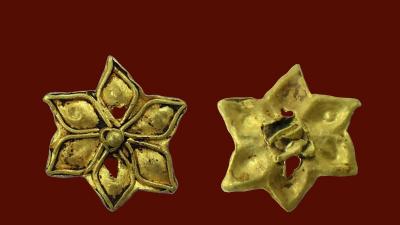 Porpanaikottai - A gold stud, a bone point and a carnelian bead have been unearthed by archaeologists at Porpanaikottai in Pudukottai district of Tamil Nadu, where the State Archaeology Department has taken up excavation this year.
Porpanaikottai - A gold stud, a bone point and a carnelian bead have been unearthed by archaeologists at Porpanaikottai in Pudukottai district of Tamil Nadu, where the State Archaeology Department has taken up excavation this year.
ISRAEL – 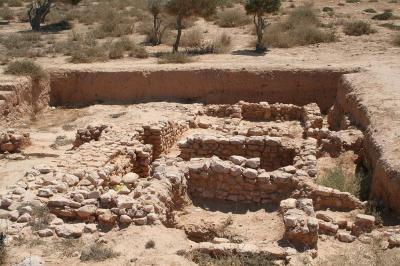 Negev - Archaeologists in Israel have made a new discovery in the Negev desert. They have uncovered a burial site that dates back 2,500 years. This site is located in southern Israel and holds dozens of skeletons, possibly belonging to women who were trafficked. The tombs found at this location, containing at least 50 skeletons, were situated at a significant junction where traders from various cultures used to meet and exchange goods and resources. The details of this discovery were published on June 9 in the Tel Aviv: Journal of the Institute of Archaeology of Tel Aviv University. Typically, burial sites in the Negev region are rounded mounds called tumuli. However, the two chambers that were recently discovered stand out because of their square shape. One of the chambers measures 23 by 23 feet (7 by 7 meters), while the other is slightly smaller, measuring 15 by 15 feet (4.5 by 4.5 meters). The location of these tombs is also significant, according to the researchers.Situated at a significant crossroads, these tombs are positioned at the meeting point of two crucial ancient paths. These paths stretch from the western region to the eastern direction, connecting Egypt to the Wadi Arabah, a region in the southern part of the Negev located south of the Dead Sea basin. Additionally, these tracks also connect to southern Jordan and the Arabian Peninsula. Within the tomb, a trove of artifacts was discovered, originating from various cultures spanning the southern Levant (the area surrounding the eastern Mediterranean), southern Arabia, and Egypt. These artifacts can be traced back to the late Iron Age and the early Persian Achaemenid period, which occurred between the seventh and fifth centuries B.C. The researchers have indicated that certain objects found at the site suggest that the human remains discovered there belonged to adult women. However, additional analysis is required to confirm this observation. For instance, the tombs contained jewelry made of copper alloy and iron, as well as ceramic vases and shells from the Red Sea, known as Cypraea shells. These shells were sometimes used by Egyptian women as talismans to protect against evil influences and attract good fortune. Additionally, the archaeologists unearthed incense holders and an alabaster tray, remnants of the once-thriving trade in myrrh and frankincense across this region. However, some of the incense containers were deliberately shattered, likely as part of a burial ritual, as noted by the researchers.
Negev - Archaeologists in Israel have made a new discovery in the Negev desert. They have uncovered a burial site that dates back 2,500 years. This site is located in southern Israel and holds dozens of skeletons, possibly belonging to women who were trafficked. The tombs found at this location, containing at least 50 skeletons, were situated at a significant junction where traders from various cultures used to meet and exchange goods and resources. The details of this discovery were published on June 9 in the Tel Aviv: Journal of the Institute of Archaeology of Tel Aviv University. Typically, burial sites in the Negev region are rounded mounds called tumuli. However, the two chambers that were recently discovered stand out because of their square shape. One of the chambers measures 23 by 23 feet (7 by 7 meters), while the other is slightly smaller, measuring 15 by 15 feet (4.5 by 4.5 meters). The location of these tombs is also significant, according to the researchers.Situated at a significant crossroads, these tombs are positioned at the meeting point of two crucial ancient paths. These paths stretch from the western region to the eastern direction, connecting Egypt to the Wadi Arabah, a region in the southern part of the Negev located south of the Dead Sea basin. Additionally, these tracks also connect to southern Jordan and the Arabian Peninsula. Within the tomb, a trove of artifacts was discovered, originating from various cultures spanning the southern Levant (the area surrounding the eastern Mediterranean), southern Arabia, and Egypt. These artifacts can be traced back to the late Iron Age and the early Persian Achaemenid period, which occurred between the seventh and fifth centuries B.C. The researchers have indicated that certain objects found at the site suggest that the human remains discovered there belonged to adult women. However, additional analysis is required to confirm this observation. For instance, the tombs contained jewelry made of copper alloy and iron, as well as ceramic vases and shells from the Red Sea, known as Cypraea shells. These shells were sometimes used by Egyptian women as talismans to protect against evil influences and attract good fortune. Additionally, the archaeologists unearthed incense holders and an alabaster tray, remnants of the once-thriving trade in myrrh and frankincense across this region. However, some of the incense containers were deliberately shattered, likely as part of a burial ritual, as noted by the researchers.
https://greekreporter.com/2023/07/08/skeletons-unearthed-negev-desert-israel/
AUTRICHE – 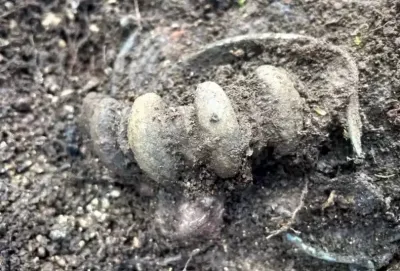
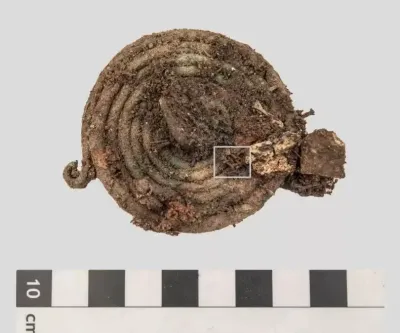 Halstatt - Archeologists from the Vienna Natural History Museum (NHM), a cremation burial containing bronze jewelry and rare surviving textile fragments have unearthed from the Early Iron Age (800-550 B.C.) burial ground at Hallstatt, Austria. Finds include a ribbed arm ring, spirals of thin wire (possibly from a fibula brooch), a bronze blade with traces of the wooden handle, and a piece of iron lead that has been identified as a belt fitting. The finds were densely packed into the grave, and it was only when the objects were detached and examined closely that archaeologists recognized the surviving traces of fabric on the undersides of the spiral discs. These might be the first archaeological evidence that textile pouches were used to contain cremated remains for burial. The researchers believe the burial was placed in a textile bag and the spiral discs were placed on top, revealing for the first time a new distinct Hallstatt culture burial practice from the Iron Age. Archaeologists also found animal bones, thought to be food for the afterlife, a bronze knife blade, and a piece of sheet iron, possibly from a belt fitting. All of the items appeared to have been deliberately bent or broken. According to the researchers, the intentional damage of metalwork was a ritual offering and may have been an expression of the death of the buried individual. The exploration of the Iron Age cemetery is far from over. With modern excavation and documentation methods, further research questions that have not yet been answered can also be clarified by the excavation campaign at the Hallstatt Salzberg.
Halstatt - Archeologists from the Vienna Natural History Museum (NHM), a cremation burial containing bronze jewelry and rare surviving textile fragments have unearthed from the Early Iron Age (800-550 B.C.) burial ground at Hallstatt, Austria. Finds include a ribbed arm ring, spirals of thin wire (possibly from a fibula brooch), a bronze blade with traces of the wooden handle, and a piece of iron lead that has been identified as a belt fitting. The finds were densely packed into the grave, and it was only when the objects were detached and examined closely that archaeologists recognized the surviving traces of fabric on the undersides of the spiral discs. These might be the first archaeological evidence that textile pouches were used to contain cremated remains for burial. The researchers believe the burial was placed in a textile bag and the spiral discs were placed on top, revealing for the first time a new distinct Hallstatt culture burial practice from the Iron Age. Archaeologists also found animal bones, thought to be food for the afterlife, a bronze knife blade, and a piece of sheet iron, possibly from a belt fitting. All of the items appeared to have been deliberately bent or broken. According to the researchers, the intentional damage of metalwork was a ritual offering and may have been an expression of the death of the buried individual. The exploration of the Iron Age cemetery is far from over. With modern excavation and documentation methods, further research questions that have not yet been answered can also be clarified by the excavation campaign at the Hallstatt Salzberg.
ISRAEL - Caesarea Maritima - A tsunami destroyed early medieval Caesarea which was then rebuilt relatively quickly, according to new evidence presented by researchers at the University of Haifa in a study published on Sunday. The research was conducted by a team from the University of Haifa School of Marine Sciences, in collaboration with the Israel Antiques Authority (IAA), and was intended to shed light on how people reacted to ancient natural disasters and to help predict future natural disasters.The research was led by National Geographic Explorer Dr. Beverly Goodman Tchernov and Charles J. Everhardt IV of the University of Haifa and has been published in the peer-reviewed Geosciences journal.
https://www.jpost.com/archaeology/article-749371
ISRAEL – Jerusalem - Authorities announced the completion of excavation work in the Church of Holy Sepulchre complex in Jerusalem, Israel, particularly the area immediately in front of the Aedicule structure, where Jesus Christ is believed to be buried. The excavation revealed early Christian layouts, new artifacts, and sections of masonry not previously seen. In addition, the restoration allowed for archaeological cleaning beneath slabs of the Aedicule. Professor Francesca Romana Stasolla, from Rome’s Sapienza University, led the effort which was part of a restoration program for the basilica’s floor. He first pointed out in a communiqué that “the excavation revealed the early Christian layout of the Aedicule, which was accessed via two white marble steps.” “In front of it, a floor of lithic slabs extended, traces of which were found in the preparation mortar,” Stasolla added, “their measurements and course can be reconstructed.” The described arrangements, the professor said, represent “the final appearance of the Rotunda at the end of the 4th century.” This is the circular area that surrounds the Aedicule, and it was dated thanks to a hoard of coins found underneath the lithic slab floor. “In front of it, a floor of lithic slabs extended, traces of which were found in the preparation mortar,” Stasolla added, “their measurements and course can be reconstructed.” The described arrangements, the professor said, represent “the final appearance of the Rotunda at the end of the 4th century.” This is the circular area that surrounds the Aedicule, and it was dated thanks to a hoard of coins found underneath the lithic slab floor.
ANGLETERRE – 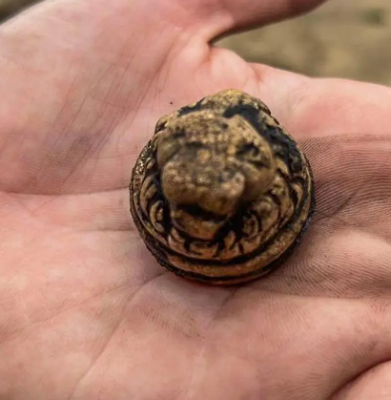
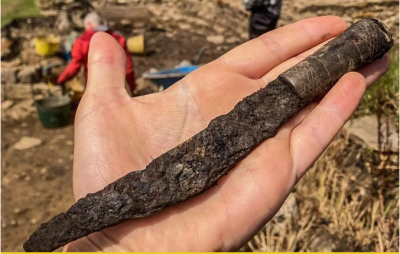 Vindolanda - Recent excavations have found a copper alloy lion head pommel that dates from AD 90 to 105 when the 9th cohort of Batavians were stationed at Vindolanda. The 9th cohort of Batavians were a mixed infantry-cavalry unit of about 1,000 men that came from a region close to the mouth of the Rhine near the modern day city of Nijmegen in the Netherlands. Batavian soldiers were first brought to Britain during the conquest period in AD 43, and also fought at Ynys Mon in present-day Anglesey where they attacked the Druid stronghold in an amphibious assault. Excavations at Vindolanda have also uncovered a bone handled knife that dates from around the same period as the Batavians, a sherd of a mortarium bow with indications that it was repaired using lead and copper alloy, a pit containing hundreds of nuts (mostly hazelnut) which dates from AD 105-108, and samian pottery depicting a hare. This season has also seen the start of a groundbreaking five year project to excavate Roman Magna, a fort that predates Hadrian’s Wall which was constructed to guard the junction of the Maiden Way Roman road with the Stanegate.
Vindolanda - Recent excavations have found a copper alloy lion head pommel that dates from AD 90 to 105 when the 9th cohort of Batavians were stationed at Vindolanda. The 9th cohort of Batavians were a mixed infantry-cavalry unit of about 1,000 men that came from a region close to the mouth of the Rhine near the modern day city of Nijmegen in the Netherlands. Batavian soldiers were first brought to Britain during the conquest period in AD 43, and also fought at Ynys Mon in present-day Anglesey where they attacked the Druid stronghold in an amphibious assault. Excavations at Vindolanda have also uncovered a bone handled knife that dates from around the same period as the Batavians, a sherd of a mortarium bow with indications that it was repaired using lead and copper alloy, a pit containing hundreds of nuts (mostly hazelnut) which dates from AD 105-108, and samian pottery depicting a hare. This season has also seen the start of a groundbreaking five year project to excavate Roman Magna, a fort that predates Hadrian’s Wall which was constructed to guard the junction of the Maiden Way Roman road with the Stanegate.




